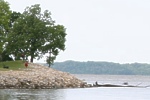BIG RIVER STATE FOREST
Big River State Forest in western Illinois? Henderson County is 8 miles north of Oquawka on the Oquawka-Keithsburg blacktop. The forest is managed primarily to demonstrate sound forestry practices with demonstrations and talks on these practices available to interested groups.
Big River State Forest is a remnant of a vast prairie woodland border area that once covered much of Illinois. Among its vegetation are two endangered plants - penstemon, commonly known as bearded tongue, and Patterson?s bindweed, which N.H. Patterson documented in the forest in 1873 for the first time anywhere.
Some of the common plants found in the prairie are big and little bluestem, Indian grass, June grass, grama grass, flower-of-an-hour, cottonweed, prairie coneflower, pale prairie coneflower, prairie bush clover, purple prairie clover and blazing star. Also found are western sunflower, kittentail, lead plant, prickly pear cactus, flowering spurge, aromatic sumac, false dragonhead, Sullivan?s milkweed, horsemint, goat?s-rue and hoary puccoon.
The 200-acre Oquawka Refuge, acquired by the state in 1925, contains the area?s oldest pine plantation. Established in 1928 and known as the Milroy Plantation, the 17-acre area contains red, white and jack pines that tower more than 50 feet high. Subsequent land purchases, beginning in 1941 and 1942, and a lease from the U.S. Army Corps of Engineers, have brought the forest to 2,900 acres.
Tent and trailer sites are available at the Riverview camping area and in the northwest corner of the forest. All campers must obtain a permit from the park office. Group camping is allowed, but groups of 25 or more must receive advance permission from the site manager.
With the Mississippi River providing water and prime habitat offered by the forest, Big River features white-tailed deer and numerous small game animals, including quail, squirrels and rabbits. To supplement existing food and improve habitat for upland game, food plots have been planted. During the waterfowl hunting season, the Mississippi River is popular for its wood ducks, blue- and green-winged teal, mallards and Canada geese.


